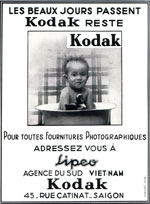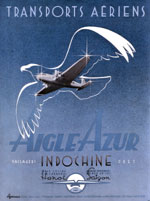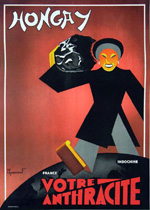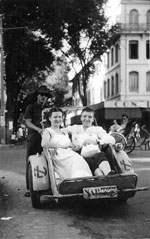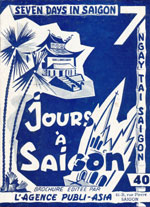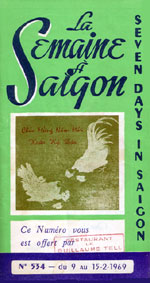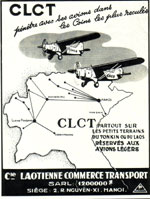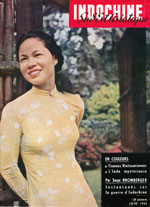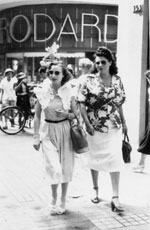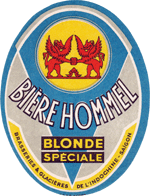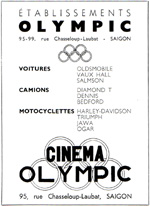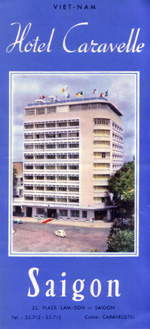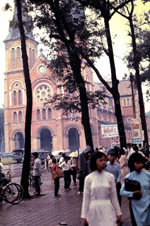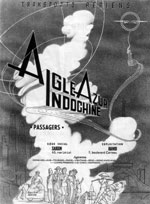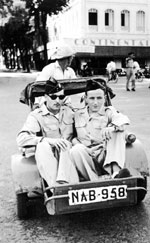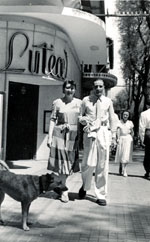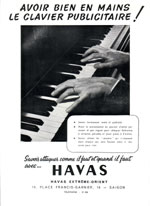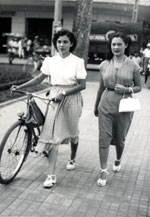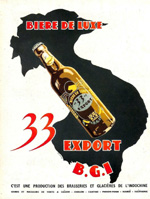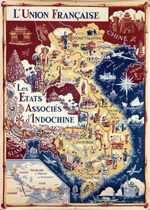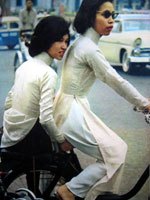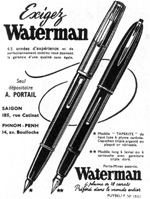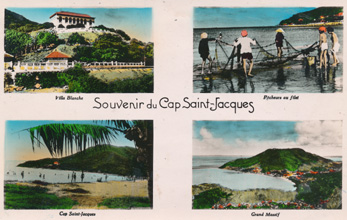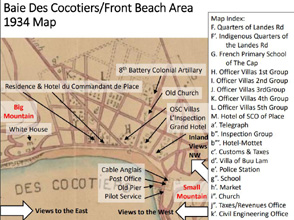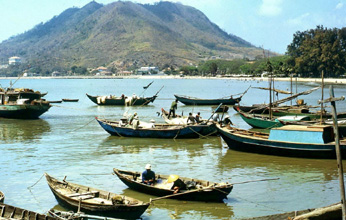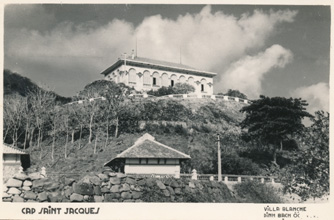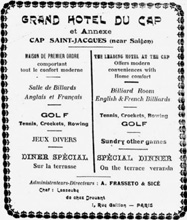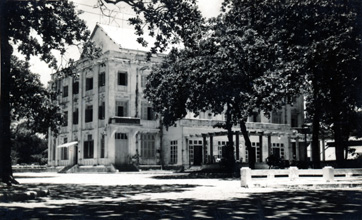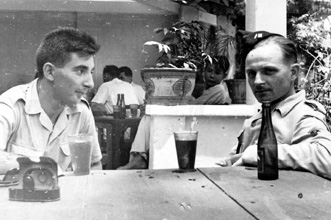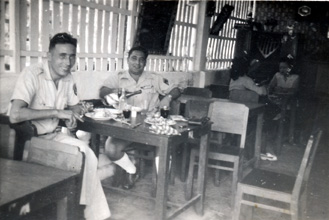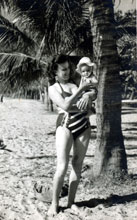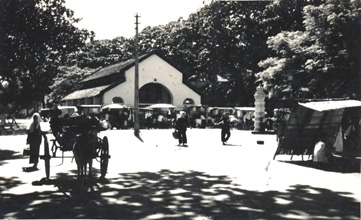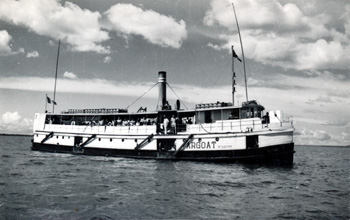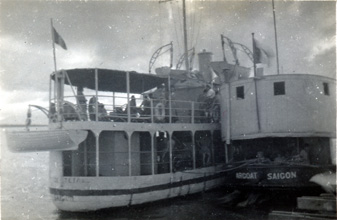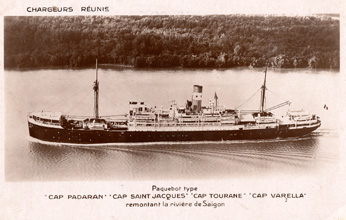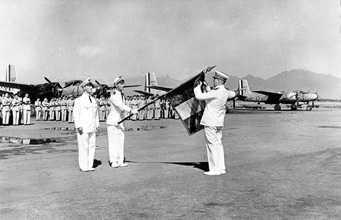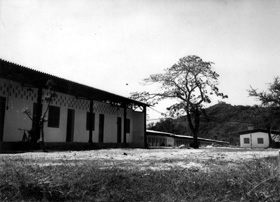




Cap St.Jacques : Point of support of Saigon
The situation of Cape St. Jacques on the China Sea.
French sailors in Cape St. Jacques
In 1953 French sailors in front the road sign located Quai Lanessan.
Cape St. Jacques - Véˋng Tû u lottery ticket

Cape St. Jacques - Véˋng Tû u lottery ticket on October 24, 1961.

Arrival of French troops in the port of Cap St. Jacques
Cape St. Jacques is located at the end of a small peninsula, 125 Km. Southwest of Saigon at the mouth of the Donnaï (in Vietnamese: SûÇng áãng Nai).
It was named by Portuguese navigators who sailed along this coast in the 15th century and named it St. Jacques.
From Marseille, the voyage could last up to two months, depending on the ports of call: Mers el Kûˋbir, Alexandria, Port Said, Djibouti, Aden, before reaching the Indian Ocean, then Colombo, Singapore ã Cape St. Jacques is the first land seen by travelers arriving in Indochina.
Transfer of French troops to the freighter "Auguste Pavie"
On February 1, 1947 French troops are transferred from the liner "Ile de France" from Marseille to the cargo ship "Auguste Pavie" bound for Saigon.
Merchant ship entering the port of Cap St. Jacques

Cap St.Jacques 1939 Map
C : Caserne (Barracks), M : Marché (Market), E : Église (Church), I Garde Indigène (Indigenous Guard), R : Bureau de la Résidence (Townhall),
T : Poste (Post Office).
1 : Grand Hôtel Grand Hotel), 2 : Hôtellerie du Cap Saint-Jacques (Annex).

Historical Population Data from 1950 to 2020
1937 |
7000 |
1950 |
* 23000 * |
|---|---|
1960 |
35000 |
| 1970 | 55000 |
| 1980 | 84000 |
| 1990 | 131000 |
| 2000 | 206000 |
| 2010 | 295000 |
| 2020 | 418000 |
* The above figures were provided by the Vietnamese administration.
With regard to the year 1950, it should be noted that there is a difference with those of the French authorities. This gives a population of the city of Cap Saint-Jacques of 12,910 inhabitants and not 23,000.
Indochina Tourist Guide
 |
Indochina Tourist Guide 1937 Edition G. Taupin & Co Paul Bert Street Hanoï (Source Bnf Gallica) |
|---|
* Seaside resort - Fortified Square - 7.000 inhabitants
- Distances to: Saigon 125 km - Baria 24 km
Ambulances, Gendarmerie, Police station, Garrison.
* By road to Baria, Bien-Hoa, Saïgon.
- "Grand Hôtel" - 56 rooms: breakfast; 0 $ 50, lunch; 2 Piastres; dinner 2 Piastres.
- "Hostellerie du Cap Saint-Jacques" - 20 rooms: breakfast; 0 $ 50, lunch; 2 Piastre, dinner 2 piastres.
* Waterway line from Saigon to Baria.
* Must see. - The Than-Tam Pagoda (Stone Buddha).
* Excursions:
- Promenade of the Grande Corniche:
- Promenade of the Petite Corniche:
- Ti-Ouan beach (rocks):
- Hill-climb (lighthouse), 200m. altitude.
To get from Saïgon to Cap Saint-Jacques, go through Bien-Hoa and turn right, after this center, at km 31, then R.C. n ô¯ 15. Very scenic route overall.

Annuaire téléphonique - Cap Saint-Jacques - Phone book
 |
Annuaire Didot-Bottin Viet-Nam 1950 Gaston Méritte 48, rue Aviateur Garros Saïgon (Sud-Viet-Nam) Tél : 21.922 René Tarrin 37, rue de Châteaudun Paris IX (France) |
|---|
- Bar S.O.S, restaurant, quai Lanessan Tél: 24
- Dang Nien, 79-81 place du Marché Tél: 19
- Dispensaire, route Ben-Dinh Tél: 9
- Douanes et Régies, recette subordonnée, route de Baria Tél: 21
- Garde du Viet-Nam (sud) brigade, boulevard Escourbet Tél: 7
- Grand Hôtel, quai Lanessan Tél: 17
_ Haut-Commissariat de France en Indochine, quai Lanessan Tél: 2
- " Sécurité (poste), boulevard Escourbet Tél: 8
- Hoc-Ho, commerçant, 20-22 place du Marché Tél: 25
- Mairie (bureau), boulevard Landes Tél: 3
- Marine (subdivision renflouements), rue Marcellot Tél: 27
- Phare, Tél: 11
- Pilotage, quai Lanessan Tél: 6
- P.T.T. receveur, quai Lanessan Tél 13 & 14
- " guichets Tél 26
- radio (station) Tél: 20
- Sûreté Nationale (Police spéciale), boulevard Landes Tél: 15
- Tran Phu Sen, restaurant, 63 place du Marché Tél: 28
- Tran Van Sanh, équipement militaire, 2 rue Arduser Tél: 16
- Travaux Publiques (subdivision), rue Rougeot Tél: 12
- Trésor, rue Marcellot Tél: 22
- Usine électrique, boulevard Escourbet Tél: 10

Baie Des Cocotiers Front Beach: Views to the West 1934 Map
Baie des Cocotiers Panoramic view

Baie Des Cocotiers Front Beach: Views to the West 1960
Why the name of Villa Blanche?
Paul Doumer Governor General of French Indochina from 1897 to 1902 wished to give the name of his wife Blanche to his summer residence in Cap Saint-Jacques.
The White House (Palace) - La Villa Blanche - BäÀch Dinh
The White Villa was built in 1898 by the architect Antoine Genet at the request of Paul Doumer, Governor-General of Indochina and future president of the French Republic.
Paul Doumer was elected President of the French Republic on 13 May 1931. On 6 May 1932, Paul Doumer was in Paris at the opening of a book fair at the Hôtel Salomon de Rothschild, talking to the author Claude Farrère. Suddenly several shots were fired by Paul Gorguloff, a mentally unstable Russian émigré. Paul Doumer was rushed to the hospital in Paris, where he died at 04:37 AM on 7 May.
The exterior walls of the White House are decorated with pearls and Greek-inspired statues.
It was later used to receive numerous dignitaries of the South Vietnamese Republic (notably NgûÇ áû˜nh Diãm also his wife madame Nhu (TräÏn Lã XuûÂn) and Nguyã
n Ván Thiãu) as well as American soldiers; today the White villa is a museum.
The Big Mountain - Le grand Massif - Nû¤i Lãn
- 1898-1902: Construction
- 1902-1907: Unofficial Indochina Governor-General (Jean Baptiste Paul Beau)
palace/retreat
- 1907-1916: Emperor Thû nh ThûÀi residence during house arrest
- 1916-1925: Official Indochina Governor-General palace/retreat
- 1926-55: Emperor BäÈo áäÀi (Head of State from 1949) palace/retreat
- 1955-75: Presidents of South Vietnam/Military Junta palace/retreat
: NgûÇ áû˜nh Diãm 1955-63
: Military Junta 1963-67
: Nguyã
n Ván Thiãu 1967-75
- 1975-1991: Out of use
- 1991: First used as a museum
- 1992: Recognized as a national historical and cultural relic;
restoration and renovation into a tourist attraction.
Marine Nationale - the French Navy
The Commandantãs office at Cape St. Jacques is located on Rue de la Concession near the Fisheries office and the R&R center.

Letter From Cholon to Cap St.Jacques (Conchinchina)
July 1936 : Letter from Cholon to Cape St.Jacques (Cochinchina)
to Monsieur Yves Le Goff (Pilot Service). Pilotage, quai Lanessan Tel: 6

Grand Hotel du Cap
The Grand Hotel du Cap was built in 1897 - The leading Hotel at the Cap.
Billiard Room - English & French Billiards.
Golf, Tennis, Crockets, Rowing.
Sundry others games.
Special Dinner on the terrace veranda.
In 1919 Administrators-Directors : A. Frasseto & Sicé
Chef: Lasseube, de chez Drouant, 1, rue Gaillon, ParisS
The Grand Hotel was on Lanessan Dock (across from BûÈi Tró¯Ã£c)
Grand Hotel
quai Lanessan
Tel: 17
Grand Hotel du Cap
directed by M. L. Andreani (during WWII).
The pleasant Cap St-Jacques beach offers you comforting sea baths, shaded walks, the Grand Hotel excellent service, a well-stocked table, a large airy bedroom.
Moderate Prices = Specials = For Families
Grand Hotel in 1971
The Grand Hotel in Véˋng Tû u - © 1971 Barry Connors - Austalian Army

Location of Véˋng Tû u/Cap St. Jacques Lighthouse

1910 The Lighthouse - Ngãn häÈi ááng - Le Phare
This lighthouse is located on small moutain (massif du phare).
1911 The Lighthouse - Ngãn häÈi ááng - Le Phare
The Cape St. Jacques lighthouse is located on top of the Telegraph mountain (now Nui Nho), with the present structure having been built in 1911.
It is 3 meters in diameter and 18 meters tall; next to it are four old French cannons (10 meters long and weighing several tons). They were formerly used to defend the region against naval attacks.
The lighthouse provides an exceptional panoramic view over the entire Cape St. Jacques (Véˋng Tû u).
It is fitted with a lighthouse lens designed by Henry Lepaute Company, located at 11, Desnouettes Street in the 15th district of Paris.
(Les Annales coloniales, 3 novembre 1910)
Les travaux de construction d'un phare sur le sommet du massif du Cap Saint-Jacques, en remplacement du phare actuel, sont poussés activement. Les caractéristiques de ce feu seront les suivantes :
Caractère : feu éclair à groupe de 2 éclats blancs, toutes les dix secondes ;
Forme : tour ronde en maçonnerie ;
Hauteurs : 1ô¯ au-dessus du sol, 15 mètres ; 2ô¯ au-dessus des hautes mers, 197 mètres.
C'est le 20 avril de cette année qu'ont commencé les travaux de ce nouveau phare dont la mise en service aura lieu probablement en février 1911.
1955 The Lighthouse - Ngãn häÈi ááng
2020 The Lighthouse - Ngãn häÈi ááng
Major modification with buttress support.
Lighthouse Profile Through Time
Showing Some Minor and Major Modifications


L'église de Cap St.Jacques Nhû Thã (Church)
The catholic church, built during the French period, is a mixture of Chinese and Western inspiratioin, a bit like the church of Notre-Dame-des-Missions-du Cygne DãEnghien in Epinay-sur-Seine in France.
The church of Cape St. Jacques is located on TräÏn Hó¯ng áäÀo Street.

In 1942 two French colonials in front of the Catholic church of
Cape St.Jacques.
Wedding at Cap St.Jacques
Cap St.Jacques, Saturday October 22, 1955 wedding of a French soldier with a Cochinchinese woman.

La plage des Cocotiers - BûÈi Tró¯Ã£c (plage du Devant)
During the ã50ãs, Cape St. Jacques was a beach resort and a R&R center for French soldiers.
- The Mayorãs office was located on the Boulevard des Landes.
- The Grand Hotel was on Lanessan Dock (across BûÈi Tró¯Ã£c).
Account of a French soldier staying at Coconut Beach on Cape St. Jacques:
ãÎAnd this is why I was granted several days of R&R at Cape St. Jacques and thatãs also where I took my first midnight swim!!!
What a pleasure it was to go out to the beach in the evening and to watch those large-shrimp fishermen, who, nearly naked in the water pulled in their nets where one could see the fluorescent eyes of these little creatures that we ate the next day.
It couldnãt last, but we knew that. Itãs not like what happened to those who came after us, and who were massacred in the same place where we were.
Jean Gourbil Decembre 1950
Indeed, on July 21st, 1952, an attack by the Vietminh resulted in 20 killed and 23 wounded in an R&R center at Cape St. Jacques.
The French R&R centre in Cap Saint-Jacques
Centre de Repos - R&R Centre - Cap Saint-Jacques - Indochina.
T.F.E.O. (Troupes Française d'Extrême-Orient - French Troops from the Far East)
Quai Lanessan
The S.O.S. bar at Cap Saint Jacques
Bar S.O.S, restaurant (Bar S.O.S is located 100 meters from the R&R)
Quai Lanessan
Tel: 24
At the end of the "40ãs and beginning of the ã50ãs, the S.O.S. bar was the meeting spot for the soldiers of the French Expeditionary Corps on R&R".
The charming bungalow lost in the greenery, thatãs the S.O.S., a bar and restaurant lost in Indochina. You can get a drink (neat), you can eat (well), and you can dance (if you want to).
Its terrace swept by the sea breeze is the refuge of poets and dreamers (indeed, quite often both).
You can gaze at the sea to the horizon, white at dawn, red and gold at sunrise then going through purple pink and blue before the divine star sinks back into it.
At night, the lights of the junks and the luminous ray of the lighthouse play strange symphonies.
Jean Petersen
A moment of rest in 1950
French soldiers drinking a beer at the S.O.S. Bar April 23 1950).
Bar S.O.S. Bar was located 100 meters from the R&R.
Cape St. Jacques in 1953
French soldiers eating fishes in Cape St.Jacques restaurant (S.O.S. bar January 1953).
Cocotiers
BûÈi Tró¯Ã£c
Preparing a fishes meal on the beach (Plage des Cocotiers August 1953).
The sandy beach opens onto the Baie des Cocotiers
BûÈi Tró¯Ã£c
Left photo: in 1953, in the foreground some Vietnamese girls and behind them French soldiers residing at the R&R center of Cap Saint-Jacques, the famous kiosk "Aux Canots Flottants" which provided beachgoers with drinks and some pastries.
Right photo: in 1939 Joseph Culat with his family in Cap St.Jacques, the photograph shows the Grand Hotel Annex in the background.
Coconut in may 1950
Twilight on Coconut Bay
La plage des Cocotiers - BûÈi Tró¯Ã£c in 1951
La plage des Cocotiers - BûÈi Tró¯Ã£c in 1955
© The color slides were taken by Mr. Emile Poizat in 1955.
Cape St.Jacques Downtown in 1955
French family in Cap St. Jacques
© The color slides were taken by Mr. Emile Poizat in 1955.
Véˋng Tû u Downtown in 1968
Véˋng Tû u's main thoroughfare with a Citroën Ami 6 in the fore ground.
Véˋng Tû u Downtown in 1971
Véˋng Tû u's main thoroughfare with a Peugeot 203 convertible ~ © Barry Connors.

Cape St.Jacques Market - ChÃ£È Véˋng Tû u
The Market Square Cape St.Jacques in 1954.
Véˋng Tû u Market - ChÃ£È Véˋng Tû u
The Market Square in 1970. © Barry Connor (Hospital Vung Tau 1970-71)
Photo Hoc Ho
Letter sent in 1936 by Hoc Ho Photo for the "Photo-Plait Company in Paris.
24-26, Market Square Cape St.Jacques.
Photo Tay Ho
Photo Tay Ho - art portrait, amateur work, enlargement photos.
42, Market Square Cape St.Jacques.
Photo Kim Són
Photo Kim Són - enlargement photos, art portrait.
91, Market Square Cape St.Jacques.



Cape St.Jacques Film Theater
January 1950 - French sailors in front of the Cap St.Jacques theater.

Véˋng Tû u Rear Beach - La Plage derrière - BûÈi Sau - 1970
The beach resort of Véˋng Tû u has attracted tourists for decades notably those from Saigon arriving every weekend.
Véˋng Tû u Rear Beach - La Plage derrière - BûÈi Sau - 2012
Archinard Island
Cape St. Jacques and Archinard Island June 1940.
One of the first Renault vehicule in Cochinchina
April 1928 : One of the first Renault Vivasix in Cape St. Jacques.

The Foreign Legion in Cape St. Jacques
Armored Cavalry Training Center

The "Cap Saint-Jacques"
The "Cap Saint-Jacques" - Auxiliary Transport - September 3 1946.
The "Pasteur" at Cape St.Jacques
cinemaFrom October 1945 to February 1956 the "Pasteur" was one of the main cogs in the comings and goings of French soldiers. There were a total of 81 round trips between France and the Far-East.
The "Pasteur" off-loaded her first passengers offshore of Cape St.Jacques because her draft did not allow her to go up the Saigon river. Landing craft or small freighters like the "Saint-Michel" or the"ûle dãOlûˋron" took over from there.
Then she went on to Tourane (Da Nang) and then on to her final destination: the Bay of Along, the port of Haiphong being equally inaccessible for the same reason as that of Saigon.
The duration of these trips was 15 days for Saigon and 20 days for Haiphong.
The Cape St. Jacques Line in Saigon
The ship ãArgoatã provided daily service from Cape St. Jacques (Rach Dua) to Saigon (dock near the Hotel Majestic), and the other ship providing the connection in the other direction was the ãArmorã.
With the Armor and the Argoat Breton sailors were quite in evidence in this part of Indochina!!
At the end of the war in Indochina in 1954, the newly secured road would outpace the river link by halving the travel time, and the line would be abandoned in 1955.
Today the trip by hydrofoil (of Russian manufacture) from Cape St. Jacques (Vung Tû u) to Saigon is made in 1 hour, 30 minutes instead of the 5 to 6 hours according to the tides at the beginning of the ã50ãs.
On the way to Cape St. Jacques... in 1949
The ship "la Chaloupe" leaving Saigon at "La Pointe des Blagueurs" on march 2nd 1949.
The ship "Tetard" at RäÀch Dã¨a (Véˋng Tû u) near "Argoat" on june 1949.
Ocean Liners near Cape St. Jacques
A Cape St. Jacques-type liner (Chargeurs Réunis Line) steaming up the Saigon River.
The liner ãCambodgeã (Messageries Maritimes Line) off Cape St. Jacques.
BûÈi Dãˋa Beach - Les Roches Noires en mai 1950
BûÈi Dãˋa Beach - Les Roches Noires
Les Roches Noires Hostel, Cap Saint-Jacques in 1960
Les Roches Noires Hostel, Cape St. Jacques, in 1949
Roches Noires Post Cards ~ 1950

The French Air Force
Transfer of Command of the Gascogne Bomb Group.
The new runway at Cape St. Jacques in 1955
Cap St.Jacques
For the Commander, a base,
For the aviator, a runway,
For the soldier garrisoned at Saigon, a weekend on the beach,
For the construction battalion, an enormous worksite with all that it represents in work and worries.
When the commander decided to turn Cape St. Jacques into an R&R center for the Expeditionary Corps after the Geneva Accords, it was a peninsula of sand and ponds. At the end of 1955 its runway was usable by B 26ãs and there were aviation installations, bridges, housing for 20,000 men, and workshops for technical services.
Nearly 400,000 square meters of earthworks representing the load of 1,000 trains of 50 cars at 10 tons each, 90 barges of 80 tons, and 14,000 truckloads representing 42,000 tons of materials loaded and unloaded, 150,000 square meters of roads and parking areas, 200,000 square meters of covered areasãÎ thatãs the result of 12 months of work.
This work is the result of hard work first of the leadership in Saigon and its annex at the Cape, which, backed by the 7/62 and 26/5 Companies built the runway in record time, then the leadership of the Cape created in June 1955 when the Annex was no longer up to the task moved in, got organized, and continued the work already begun.
On July 14th, 1955 the runway was officially opened by the landing of 21 B 26 aircraft. As of August 1st, there were never fewer than 30 aircraft on the airport, with landings varying daily from 30 to 80.
At the end of the year after an exceptional rainy season, no repairs were necessary and on December 15th, operations with 28-ton ãPrivateerã aircraft confirmed the quality of the job.
A workshop in one of the ten "Sarrade and Galtier" hangars
Right: The "Vigie" building at RäÀch Dã¨a.
The military piers at RäÀch Dã¨a were built in the estuary of the Sông Dinh River to serve the maritime transit needs of the units and services stationed at Cape St.Jacques.
Itãs the only place on the peninsula where ships up to 5 meters draft (ships of 4 to 6,000 tons) can dock at any time. This draft can go to 10 meters at high tide.
Cap St.Jacques Infantry Training Center
The entrance to the Training Center is guarded by soldiers from the Foreign Legion.
Executive housing development
Left: The G.C.R.housing development.
Right: Officer housing development.
Two housing developments were built at Cape St. Jacques in 1955, one for army and air force officers, and the other for the families of the G.C.R (Radio control Group) special services and the S.T.R. (Technical Research Services ã Vietminh communications decryption).
Left: Interior of G.C.R. housing.
Right: Officerãs Mess.
Begun in May 1955 for the executive development, in August for the G.C.R., construction went on until 1956, but the buildings were occupied as of December 1955.
After the departure of French troups in April 1956
After the departure of French troops in April 1956 the base was taken over by American advisors and it became the headquarters for the Australian expeditionary corps as well as for certain American units.
It would again be occupied after 1975 by the Soviets who would run as a joint Russian-Vietnamese operation the ãVietsovpetroã company with the Vietnamese.
The French group, Total, (in partnership with Petrovietnam) operated two platforms offshore of Cape St. Jacques.
This region has become the petroleum center of Vietnam where gas and crude operations dominate the economy of the city and contribute to the main revenue, the budget of Vietnam, and to the export volume.
Uncontrolled construction of numerous hotels as well as an amusement park (with aerial tramway!) above the White Villa has unfortunately and definitively disfigured the coastline of this town.
The Infantry Training Center
The Radio Broadcast Center
The radio broadcasting and receiving installations.
In order to assure connections between the base and the outside world, it was necessary to build transmitting and receiving installations able to link Cape St. Jacques with Paris and to the capitals of allied countries in Southeast Asia.
Three units were built by the engineering department and fitted out by the Radio Services and other user services:
- 1 transmitting center including a inter-forces station, an air station, and an intelligence station.
- 1 receiving center including an inter-forces station and an intelligence station.
- 1 transmitting/receiving center in the small mountain including the technical facilities of the signal corps.
The Broadcast Center
The inter-forces station consists of 10 transmitters, 2 of which are 10 kilowatts and 3 antenna arrays.
- 2 diamond-shaped antennas aimed at Paris and mounted on 21-meter towers.
- 5 medium-range antennas aimed at Singapore, Tokyo, Bangkok, and Manila, mounted on 15- and 20-meter masts.
- finally, 4 antennas for in-country communications in Indochina, mounted on 15-meter masts.
Cap St.Jacques by François Sully
Photo taken by François Sully.
François Sully (1927-1971) as a French journalist and photographer best known for his work during the Vietnam War. Sully was one of the earliest journalists to cover the Vietnam War and spent 24 years in Indochina. At the time of his death in a command helicopter crash near the Cambodian border, he was viewed as the dean of the Saigon press corps.
The cliff of Cap St.Jacques (Véˋng Tû u)
The cliff of Cap St.Jacques (Véˋng Tû u) is now called Méˋi Nghinh Phong (literally meaning "Cape of breeze welcome" or "Cape of greeting the wind").

Souvenir of Cap St.Jacques







